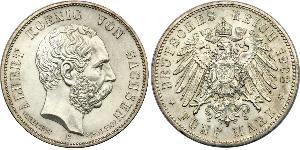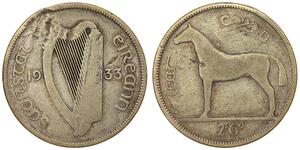1 Thaler
1828, KIngdom of Bavaria, Ludwig I. Silver "Family" Thaler Coin. PCGS UNC+
Mint Year: 1828
Mint Place: Munich
Reference: Devenport 589, AKS 74, KM-814. R!
Condition: Certified and graded by PCGS as UNC (Details: Cleaned!)
Denomination: "Family" Thaler - This coin was an Inspiration for the famour Russian Family Rouble Coin
Material: Silver (.833)
Diameter: 38mm
Weight: 28gm
Obverse: Bust of King Louis I (Ludwig I) of Bavaria right. Designer's signature (G. VOIGHT) below bust truncation.
Legend: LUDWIG I KOENIG VON BAYERN / ZEHN EINE FEINE MARK
Reverse: Central portrait of Queen Therese von Bayern, surrounded by the portraits of the Royal Family.
Legend: SEGEN DES HIMMELS (" Blessing from Heaven! ") / 1828
One-year type commemorating the Royal Family with their circled portraits surrounding the central portrait of Therese von Bayern. This beautiful coin cought the attention of Nicholas I of Russia, who ordered a similar piece to be struck, honoring his family. A very nicely preserved and certified specimen of the beautiful and popular type!
The Kingdom of Bavaria was a German state that existed from 1806–1918. Elector Maximilian I Joseph of the House of Wittelsbach became the first King of Bavaria in 1806. The monarchy would remain held by the Wittelsbachs until the kingdom's dissolution in 1918. Most of Bavaria's modern-day borders were established after 1814 with the Treaty of Paris, in which Bavaria ceded Tyrol and Vorarlberg to the Austrian Empire while receiving Aschaffenburg and parts of Hesse-Darmstadt. As a state within the German Empire, the kingdom was second in size only to the Kingdom of Prussia. Since the unification of Germany in 1871, Bavaria has remained part of Germany to the present day.
Ludwig I (also rendered in English as Louis I ) ( 25 August 1786 in Strasbourg – 29 February 1868 in Nice) was king of Bavaria from 1825 until the 1848 revolutions in the German states.He was the son of Count Palatine Maximilian Joseph of Zweibrücken by his first wife Augusta Wilhelmine of Hesse-Darmstadt. At the time of his birth, his father was an officer in the French army stationed at Strasbourg. He was the godson and namesake of Louis XVI of France. On 1 April 1795 his father succeeded Ludwig's uncle, Charles II, as duke of Zweibrücken, and on 16 February 1799 became Elector of Bavaria and Count Palatine of the Rhine, the Arch-Steward of the Empire, and Duke of Berg on the extinction of the Sulzbach line with the death of the elector Charles Theodore. His father assumed the title of King of Bavaria on 1 January 1806.Since 1803 Ludwig studied in Landshut where he was taught by Johann Michael Sailer and in Göttingen. In October 1810, he married Therese of Saxe-Hildburghausen (1792–1854), the daughter of Frederick, Duke of Saxe-Hildburghausen. The wedding was the occasion of the first ever Oktoberfest.Ludwig strongly rejected the alliance of his father with Napoleon I of France but in spite of his anti-French politics the crown prince had to join the emperor's wars with allied Bavarian troops in 1806 and under François Joseph Lefebvre in 1809. In 1817 Ludwig was involved in the fall of Prime Minister Count Max Josef von Montgelas. He succeeded his father on the throne in 1825.Ludwig's rule was strongly affected by his enthusiasm for the arts and women and by his overreaching royal assertiveness. An enthusiast also for the German Middle Ages, Ludwig ordered the re-erection of several monasteries in Bavaria which had been closed during the German Mediatisation. He reorganized the administrative regions of Bavaria in 1837 and re-introduced the old names Upper Bavaria , Lower Bavaria , Franconia , Swabia , Upper Palatinate and Palatinate . He changed his royal titles to Ludwig, King of Bavaria, Duke of Franconia, Duke in Swabia and Count Palatinate of the Rhine .

|
发布人:
anonymous 2024-04-11 |
|
||
|
||
|
||
|
||
|
||
1/2 Crown 爱尔兰共和国
本组有 44 钱币 / 43 售价
⇑

-600-300-nwusHgTyqXcAAAGOOA4L5Mrg.jpg)

-300-150-FA0KbzbiPsQAAAFLVTz6AggR.jpg)
 Deutsch
Deutsch Русский
Русский Українська
Українська English
English Italiano
Italiano Français
Français Español
Español 汉语
汉语












